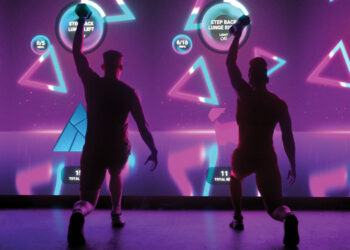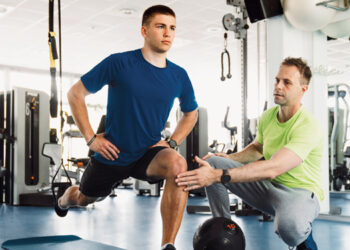There are many important components to an effective small group training or functional program — trainers, equipment and engaged clients. However, an often overlooked essential is the importance of the design features of your small group or functional training space.
Of all the areas in your health club, the small group and functional training spaces arguably depend the most on purposeful design.
Starting Point
“‘Practical and effective’ is the first place you start before you fancy anything up,” said Bryan Green, the founder and CEO of Aktiv Solutions. “To create a great space for functional training, you’ve got to create a great functional design first.” Above all, your small group fitness area has to be practical. Making a space with all the bells and whistles, but insufficient space, would be pointless. As would be making a big, open space with no clear direction.
Furthermore, your small group and functional workout space has to be in its own separate area, but still a part of the gym.
“The starting point is carving out a dedicated space that doesn’t impede upon adjacent spaces,” said Aaron Moore, the director of operations at VIDA Fitness. “Next, account for ease of entry and exit, and comfortable traffic flow within and around the space.”
At the absolute core of your design plan, you have to determine the obvious dimensions and components of the space — length, width, height, features and equipment. But within those elements, the space has to also take on a life of its own.
Design Techniques
“You want to start off with the best environment you can — a place that is a showcase,” said Green. “A lot of our technique is to create an environment that’s approachable. It needs to feel inclusive.”
Your primary goal in the health club as a whole is creating a welcoming atmosphere for members and potential members. The same concept should apply to the individual areas of the club.
“What we know about functional training today is it breeds a social aspect to membership,” continued Green. “It creates an opportunity for members to engage with each other or share in a general energetic way. They’re training together, versus in an isolated way.”
But to achieve this goal, the space must be functional. Engineer a way to store equipment efficiently, that allows for easy set up and break down of workouts or group programs. “Having smart, compact storage that preserves the space within the training area, not just for traffic management, but also for safety, is vital,” said Green.
And don’t be afraid to go with a local designer if you’re looking for a very particular type of storage set up. “Our needs are very specific, so we started creating custom storage solutions about three years ago with a local metal fabricator,” said Moore.
Being Trendy
“Before we fully commit to any new project, we always heavily research everything that’s relevant in our marketplace as well as a few top performers around the country,” said Moore. “This really gives us a good idea of what works, what doesn’t, and what we want to avoid at all costs.”
There is a difference between a design that looks good and a design that’s trendy. The two aren’t mutually exclusive, however — it’s possible to have both. “You want something that absolutely is more energetic and fun, so I think seizing an opportunity to tailor the space is essential,” said Green.
Staying on top of the industry’s trends, however, doesn’t mean you can’t also become cutting-edge in the design and planning of your fitness spaces.
“Part of our emphasis in evaluating trends is looking for the opportunity to create something new or, perhaps more realistically, improve upon the current trends and play a small part in moving the industry forward for our members and clients,” said Moore.
The Right Flooring
The flooring in your small group and functional spaces is just as important as any other design element. The floor is the part of the space participants will engage with the most, so it needs to be of the highest quality and practical for the types of training you offer.
“I always like to start with how I can best provide safety and comfort to our clients,” said Moore. “From a broader perspective, we typically go with darker colored flooring, as it looks better for longer. We also look for durable flooring that doesn’t flake, chip, scratch or scuff.”
Unequivocally, the most important feature of your flooring should be slip resistance. “Slip-resistant flooring is also important in a high-sweat environment,” said Moore.
“You want something that clearly is a non-slip surface, something that is hygienic, that can be easily cleaned — it’s going to get sweaty,” echoed Green.
Keeping your members safe with your flooring should be goal No. 1. But if you can also pick a floor that fits your space’s motif, that’s even better.
Bringing It All Together
At the end of the day, you should be aiming to design a small group or functional fitness space that encourages strong member participation, no matter what your individual design preferences are.
Keeping that goal at the forefront of the design process will allow you to create a workout space that is enjoyable to be in, and that also helps produce real fitness results.
“We’re very, very sensitive to trying to create a space that pulls out the intimidation factor,” said Green. “Oftentimes very heavy, sports-performance oriented spaces can be alienating, especially for first-time members.”
You want your members to walk through your doors and immediately feel comfortable. Designing a small group and functional training area with the right amount of space, the perfect equipment, a sweat-resistant floor, and other design elements will bring you closer to that end.
“Think creatively about ways you can add to your desired experience,” said Moore. “Are you going for high energy and a departure from the daily grind? If so, a dark room with colored, theatrical lighting might be good. Does your program require precision instruction and monitoring of all movements? If so, a well-lit space might be more appropriate.”
Whichever route you choose, be purposeful in your design.
Stay ahead in the fitness industry with exclusive updates!
Bobby is the former assistant editor of Club Solutions Magazine.










